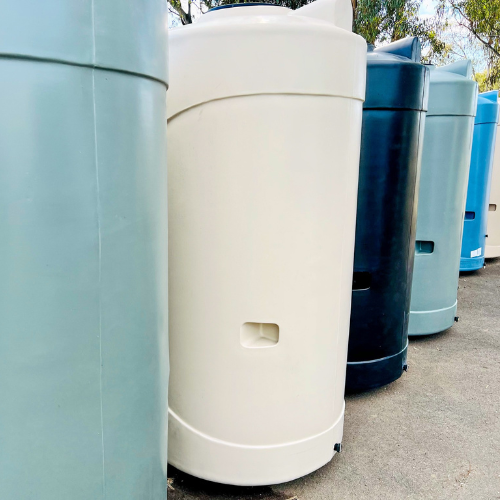Rainwater Tanks and Pumps
How to get the water quality you want
A rainwater collection system has three components:
+ A catchment system is the area onto which rainwater falls and is collected
+ A storage system that accumulates rainwater for future use
+ A delivery system that transfers water from its place of storage to its place of use
There are lots of reasons why people install rainwater collection systems, and the intended purpose of the water will dictate the level of water quality that is required and the sophistication of the collection system.
For example, a property owner collecting water for fire-fighting purposes has little concern about water quality whilst a householder without a mains water supply will have much higher expectations about water quality for domestic use and consumption.
The key therefore is to build the collection system to reflect the intended use of the water.

Stopping contaminants from entering your tank
The catchment system is the roof area that collects rainwater and the network of gutters and downpipes that channels the water to storage tanks. After a dry spell, the roof area can be heavily contaminated with leaves, dust, pollen, insects and animal waste, and there are two key steps that can improve the quality of water being delivered to the tank.
The first is to install gutter guards which are plastic or metal screens fitted over gutters to prevent debris getting into the gutter and restricting free flow of water. The free flow of water in gutters ensures that water tanks fill more quickly when it rains and that the water is much cleaner as the gutter guards filter-out debris and contaminants.
The second option is to install a first-flush diverter. The first few minutes of rainfall washes debris and contaminants off the roof and into the gutters. A first-flush device prevents the contaminated water in the gutters and downpipes from entering the water tank by diverting the water into either stormwater drainage or a secondary storage container.
Keeping out insects and other beasties
As rainwater is delivered to the water tank, it will pass through a fine strainer on top of the tank. As rainwater might contain a cocktail of dust, seeds and organic matter, if this is allowed to build-up on the strainer, weed growth can quickly occur and the roots can mat and clog the strainer and result in overflow. This can be inhibited by using a tight-fitting dust cover that starves plant matter of sunlight necessary for growth and by regular cleaning of the strainer. As the name implies, the dust cover prevents wind-blown contaminants entering the tank, but also prevents sunlight entering the water tank and inhibits algae growth and serves as a physical barrier to mosquitoes that lay their eggs in still water.
A rainwater tank is fitted with an overflow, and a pipe is typically connected to the overflow that directs water a few metres away from the tank. It is important that the discharge-end of the overflow pipe is fitted with an overflow screen that is a barrier to small animals such as frogs and insects.
Cleaning the tank
Even if you are diligent about minimising the debris that enters the storage tank, over time, sludge and sediment will accumulate and it may be necessary to clean the water tank.
You can clean a rainwater tank yourself using a hose or pressure washer. If your tank is large or needs anti-bacterial treatment or disinfection, we recommend using a company that specialises in tank cleaning. Also, many specialist contractors have mobile storage tanks and can decant the water from one tank to another and return the water after the tank clean is complete.
After draining the water from the tank, leave the drain valve open and remove the access hatch on top of the tank. Clean the interior using a high-pressure hose to remove sediment and sludge and chase all the contaminants out of the tank. If you are going to use any chemicals, please ensure your get competent professional advice, wear appropriate protective materials and avoid working in confined spaces.

Clean or replace your filters
The final element is your delivery system, which is the ‘business end’ of the rainwater collection system and typically involves a pump and a filter. If the purpose of the rainwater is to water your garden, you’ll probably only have a pump, but if you are using rainwater for domestic purposes, you will need a filter system.
If you intend to use the water to top-up a swimming pool or for an evaporative cooling system, a single filter will probably be adequate. If the water is for domestic purposes such as laundry, a double filter with a pre-filter and a fine filter would be recommended. If the water is intended for domestic consumption, a triple system of pre-filter, fine filter and UV filter is recommended. A UV filter uses ultraviolet rays to penetrate harmful pathogens and destroy illness-causing microorganisms by attacking their genetic core. UV filtration kills 99.9% of bacteria and is environmentally friendly and chemical free.
It is a good practice to regularly change out the filter cartridges on your system. Some filters can be cleaned and re-used while others are single-use only. Filters should be changed every twelve months or sooner, depending on how dirty the water is and how much water is being filtered by the system. A whole-of-house system will probably require filter changes every six months. If you are using a UV filtration system, you should regularly check to ensure the UV light is working, and it is good practice to have a spare light as a standby. If the light fails, you should obtain assistance from a qualified professional to replace it.
If you follow these simple steps and take reasonable care, you can rely upon your rainwater harvesting system to deliver fit-for-purpose water for many years, reducing your dependence on mains water and doing your bit for the environment.

